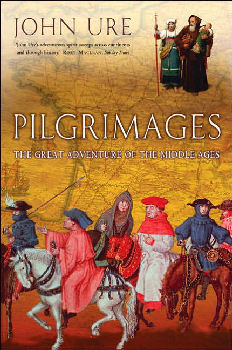
|
Posted April 25, 2006
Book: Pilgrimages: The Great Adventure of the Middle Ages Author: John Ure Avalon, NY, 2006, pp. 258 An Excerpt from the Jacket:
An Excerpt from the Book: With so many reasons to come to Rome throughout the Middle Ages, and with such a numerous, if erratic, flow of pilgrims, one wonders how they made the journey from all over western and northern Europe. Englishmen naturally tended to come through France, wth the complications that ensued in times of war between the two countries. Scandinavians tended to come via the German states. Some came from even farther afield: Nicholas of Munkathvera had to sail from Iceland to Norway before he could even begin the overland journey. But all of their routes converged on the great obstacle of the Alps. Ice, snow, avalanches and vertiginous passes were a feature of most crossings. The Great St. Bernard Pass, 8,000 feet above sea level and covered in snow for three-quarters of the year, was the most popular crossing point, partly on account of its famous hospice, founded by St. Bernard himself in 962. But others chose to cross by the Simplon or Mount Cenis Passes. Traveller’s tales of the hazards are all too numerous. James Harpur has recounted a number of the more spectacular mishaps in his Sacred Tracks. Aelfsige, Archbishop of Canterbury, froze to death while attempting the Alpine crossing in 959. John of Canterbury, less seriously, found his ink bottle frozen solid on the St. Bernard Pass in 1188, and his beard ‘congealed in a long icicle’. Adam of Usk, when banished to Rome in 1402, had himself blindfolded when he was carried over the passes in an ox-wagon, so that he would be spared the horrid vision of the perilous falls below. It was not until the romantic movement of the nineteenth century that such Alpine phenomena were to be considered stimulating rather than merely frightening. To help with finding the best route and keeping to it, a number of maps and guides were produced at different periods. One of the most memorable of these was either devised or copied by the chronicler Matthew Paris from St. Albans in 1253. His map consists of a long series of strips, indicating places and features on the road, not only to Rome but to the Holy Land as well: rivers, mountains and lakes are shown to warn the intending pilgrim of hazards or obstacles. His map was to be the forerunner of many such road charts in subsequent centuries, for use not only of pilgrims but of all travellers. Table of Contents: 1. Prologue: the adventure of a lifetime 2. The motivation for pilgrimage: saints and sinners 3. Jerusalem: the archetypal pilgrimage 4. Canon Casola: the privileged pilgrim 5. Rome: the Eternal City pilgrimage 6. Margery Kempe: the unpopular pilgrim 7. Santiago de Compostela: the romantic pilgrimage 8. John of Gaunt: the overmighty pilgrim; and Andrew Boorde: the merry pilgrim 9. Canterbury: the political pilgrimage 10. Erasmus: the skeptical pilgrim 11. Less frequented pilgrimages: Mount Athos, Glastonbury, Durham, Walsingham 12. Brother Felix: the popular pilgrim 13. Armed pilgrimages: crusades to the Holy Land; the Albigensian Crusade; the pilgrimage of grace 14. Pilgrimage and the Black Death 15. Sir John Mandeville: the literary pilgrim 16. John Bunyan: the allegorical pilgrim 17. A personal epilogue |
|
